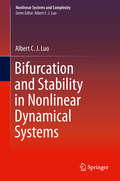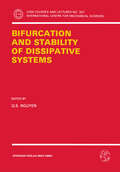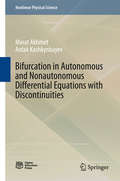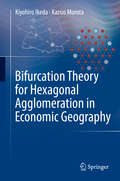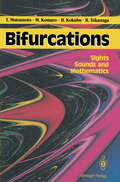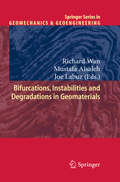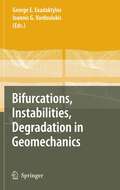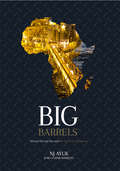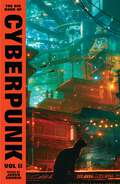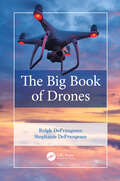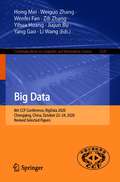- Table View
- List View
Bifurcation and Localisation Theory in Geomechanics
by Hans-Bernd Mühlhaus; Arcady V. Dyskin; Elena PasternakThis work contains proceedings of a workshop on Bifurcation and Localisation Theory in Geomechanics, held in Perth, Australia in 1999. It covers a range of themes from classic civil engineering subjects to non-linear and non-unique geological phenomena.
Bifurcation and Stability in Nonlinear Discrete Systems (Nonlinear Physical Science)
by Albert C. LuoThis book focuses on bifurcation and stability in nonlinear discrete systems, including monotonic and oscillatory stability. It presents the local monotonic and oscillatory stability and bifurcation of period-1 fixed-points on a specific eigenvector direction, and discusses the corresponding higher-order singularity of fixed-points. Further, it explores the global analysis of monotonic and oscillatory stability of fixed-points in 1-dimensional discrete systems through 1-dimensional polynomial discrete systems. Based on the Yin-Yang theory of nonlinear discrete systems, the book also addresses the dynamics of forward and backward nonlinear discrete systems, and the existence conditions of fixed-points in said systems. Lastly, in the context of local analysis, it describes the normal forms of nonlinear discrete systems and infinite-fixed-point discrete systems. Examining nonlinear discrete systems from various perspectives, the book helps readers gain a better understanding of the nonlinear dynamics of such systems.
Bifurcation and Stability in Nonlinear Dynamical Systems (Nonlinear Systems and Complexity #28)
by Albert C. LuoThis book systematically presents a fundamental theory for the local analysis of bifurcation and stability of equilibriums in nonlinear dynamical systems. Until now, one does not have any efficient way to investigate stability and bifurcation of dynamical systems with higher-order singularity equilibriums. For instance, infinite-equilibrium dynamical systems have higher-order singularity, which dramatically changes dynamical behaviors and possesses the similar characteristics of discontinuous dynamical systems. The stability and bifurcation of equilibriums on the specific eigenvector are presented, and the spiral stability and Hopf bifurcation of equilibriums in nonlinear systems are presented through the Fourier series transformation. The bifurcation and stability of higher-order singularity equilibriums are presented through the (2m)th and (2m+1)th -degree polynomial systems. From local analysis, dynamics of infinite-equilibrium systems is discussed. The research on infinite-equilibrium systems will bring us to the new era of dynamical systems and control. Presents an efficient way to investigate stability and bifurcation of dynamical systems with higher-order singularity equilibriums;Discusses dynamics of infinite-equilibrium systems;Demonstrates higher-order singularity.
Bifurcation and Stability of Dissipative Systems (CISM International Centre for Mechanical Sciences #327)
by Q. S. NguyenThe first theme concerns the plastic buckling of structures in the spirit of Hill’s classical approach. Non-bifurcation and stability criteria are introduced and post-bifurcation analysis performed by asymptotic development method in relation with Hutchinson’s work. Some recent results on the generalized standard model are given and their connection to Hill’s general formulation is presented. Instability phenomena of inelastic flow processes such as strain localization and necking are discussed. The second theme concerns stability and bifurcation problems in internally damaged or cracked colids. In brittle fracture or brittle damage, the evolution law of crack lengths or damage parameters is time-independent like in plasticity and leads to a similar mathematical description of the quasi-static evolution. Stability and non-bifurcation criteria in the sense of Hill can be again obtained from the discussion of the rate response.
Bifurcation Dynamics in Polynomial Discrete Systems (Nonlinear Physical Science)
by Albert C. LuoThis is the first book focusing on bifurcation dynamics in 1-dimensional polynomial nonlinear discrete systems. It comprehensively discusses the general mathematical conditions of bifurcations in polynomial nonlinear discrete systems, as well as appearing and switching bifurcations for simple and higher-order singularity period-1 fixed-points in the 1-dimensional polynomial discrete systems. Further, it analyzes the bifurcation trees of period-1 to chaos generated by period-doubling, and monotonic saddle-node bifurcations. Lastly, the book presents methods for period-2 and period-doubling renormalization for polynomial discrete systems, and describes the appearing mechanism and period-doublization of period-n fixed-points on bifurcation trees for the first time, offering readers fascinating insights into recent research results in nonlinear discrete systems.
Bifurcation Dynamics of a Damped Parametric Pendulum (Synthesis Lectures on Mechanical Engineering)
by Yu Guo Albert C.J. LuoThe inherent complex dynamics of a parametrically excited pendulum is of great interest in nonlinear dynamics, which can help one better understand the complex world. Even though the parametrically excited pendulum is one of the simplest nonlinear systems, until now, complex motions in such a parametric pendulum cannot be achieved. In this book, the bifurcation dynamics of periodic motions to chaos in a damped, parametrically excited pendulum is discussed. Complete bifurcation trees of periodic motions to chaos in the parametrically excited pendulum include: period-1 motion (static equilibriums) to chaos, and period-���� motions to chaos (���� = 1, 2, ···, 6, 8, ···, 12). The aforesaid bifurcation trees of periodic motions to chaos coexist in the same parameter ranges, which are very difficult to determine through traditional analysis. Harmonic frequency-amplitude characteristics of such bifurcation trees are also presented to show motion complexity and nonlinearity in such a parametrically excited pendulum system. The non-travelable and travelable periodic motions on the bifurcation trees are discovered. Through the bifurcation trees of travelable and non-travelable periodic motions, the travelable and non-travelable chaos in the parametrically excited pendulum can be achieved. Based on the traditional analysis, one cannot achieve the adequate solutions presented herein for periodic motions to chaos in the parametrically excited pendulum. The results in this book may cause one rethinking how to determine motion complexity in nonlinear dynamical systems.
Bifurcation in Autonomous and Nonautonomous Differential Equations with Discontinuities (Nonlinear Physical Science)
by Marat Akhmet Ardak KashkynbayevThis book focuses on bifurcation theory for autonomous and nonautonomous differential equations with discontinuities of different types – those with jumps present either in the right-hand side, or in trajectories or in the arguments of solutions of equations. The results obtained can be applied to various fields, such as neural networks, brain dynamics, mechanical systems, weather phenomena and population dynamics. Developing bifurcation theory for various types of differential equations, the book is pioneering in the field. It presents the latest results and provides a practical guide to applying the theory to differential equations with various types of discontinuity. Moreover, it offers new ways to analyze nonautonomous bifurcation scenarios in these equations. As such, it shows undergraduate and graduate students how bifurcation theory can be developed not only for discrete and continuous systems, but also for those that combine these systems in very different ways. At the same time, it offers specialists several powerful instruments developed for the theory of discontinuous dynamical systems with variable moments of impact, differential equations with piecewise constant arguments of generalized type and Filippov systems.
Bifurcation Theory: An Introduction with Applications to Partial Differential Equations (Applied Mathematical Sciences #156)
by Hansjörg KielhöferIn the past three decades, bifurcation theory has matured into a well-established and vibrant branch of mathematics. This book gives a unified presentation in an abstract setting of the main theorems in bifurcation theory, as well as more recent and lesser known results. It covers both the local and global theory of one-parameter bifurcations for operators acting in infinite-dimensional Banach spaces, and shows how to apply the theory to problems involving partial differential equations. In addition to existence, qualitative properties such as stability and nodal structure of bifurcating solutions are treated in depth. This volume will serve as an important reference for mathematicians, physicists, and theoretically-inclined engineers working in bifurcation theory and its applications to partial differential equations. The second edition is substantially and formally revised and new material is added. Among this is bifurcation with a two-dimensional kernel with applications, the buckling of the Euler rod, the appearance of Taylor vortices, the singular limit process of the Cahn-Hilliard model, and an application of this method to more complicated nonconvex variational problems.
Bifurcation Theory: An Introduction with Applications to PDEs (Applied Mathematical Sciences #156)
by Hansjörg KielhöferIn the past three decades, bifurcation theory has matured into a well-established and vibrant branch of mathematics. This book gives a unified presentation in an abstract setting of the main theorems in bifurcation theory, as well as more recent and lesser known results. It covers both the local and global theory of one-parameter bifurcations for operators acting in infinite-dimensional Banach spaces, and shows how to apply the theory to problems involving partial differential equations. In addition to existence, qualitative properties such as stability and nodal structure of bifurcating solutions are treated in depth. This volume will serve as an important reference for mathematicians, physicists, and theoretically-inclined engineers working in bifurcation theory and its applications to partial differential equations.
Bifurcation Theory for Hexagonal Agglomeration in Economic Geography
by Kiyohiro Ikeda Kazuo MurotaThis book contributes to an understanding of how bifurcation theory adapts to the analysis of economic geography. It is easily accessible not only to mathematicians and economists, but also to upper-level undergraduate and graduate students who are interested in nonlinear mathematics. The self-organization of hexagonal agglomeration patterns of industrial regions was first predicted by the central place theory in economic geography based on investigations of southern Germany. The emergence of hexagonal agglomeration in economic geography models was envisaged by Krugman. In this book, after a brief introduction of central place theory and new economic geography, the missing link between them is discovered by elucidating the mechanism of the evolution of bifurcating hexagonal patterns. Pattern formation by such bifurcation is a well-studied topic in nonlinear mathematics, and group-theoretic bifurcation analysis is a well-developed theoretical tool. A finite hexagonal lattice is used to express uniformly distributed places, and the symmetry of this lattice is expressed by a finite group. Several mathematical methodologies indispensable for tackling the present problem are gathered in a self-contained manner. The existence of hexagonal distributions is verified by group-theoretic bifurcation analysis, first by applying the so-called equivariant branching lemma and next by solving the bifurcation equation. This book offers a complete guide for the application of group-theoretic bifurcation analysis to economic agglomeration on the hexagonal lattice.
Bifurcation Theory of Impulsive Dynamical Systems (IFSR International Series in Systems Science and Systems Engineering #34)
by Kevin E.M. Church Xinzhi LiuThis monograph presents the most recent progress in bifurcation theory of impulsive dynamical systems with time delays and other functional dependence. It covers not only smooth local bifurcations, but also some non-smooth bifurcation phenomena that are unique to impulsive dynamical systems. The monograph is split into four distinct parts, independently addressing both finite and infinite-dimensional dynamical systems before discussing their applications. The primary contributions are a rigorous nonautonomous dynamical systems framework and analysis of nonlinear systems, stability, and invariant manifold theory. Special attention is paid to the centre manifold and associated reduction principle, as these are essential to the local bifurcation theory. Specifying to periodic systems, the Floquet theory is extended to impulsive functional differential equations, and this permits an exploration of the impulsive analogues of saddle-node, transcritical, pitchfork and Hopf bifurcations.Readers will learn how techniques of classical bifurcation theory extend to impulsive functional differential equations and, as a special case, impulsive differential equations without delays. They will learn about stability for fixed points, periodic orbits and complete bounded trajectories, and how the linearization of the dynamical system allows for a suitable definition of hyperbolicity. They will see how to complete a centre manifold reduction and analyze a bifurcation at a nonhyperbolic steady state.
Bifurcations: Sights, Sounds, and Mathematics
by Takashi Matsumoto Motomasa Komuro Hiroshi Kokubu Ryuji TokunagaBifurcation originally meant "splitting into two parts. " Namely, a system under goes a bifurcation when there is a qualitative change in the behavior of the sys tem. Bifurcation in the context of dynamical systems, where the time evolution of systems are involved, has been the subject of research for many scientists and engineers for the past hundred years simply because bifurcations are interesting. A very good way of understanding bifurcations would be to see them first and study theories second. Another way would be to first comprehend the basic concepts and theories and then see what they look like. In any event, it is best to both observe experiments and understand the theories of bifurcations. This book attempts to provide a general audience with both avenues toward understanding bifurcations. Specifically, (1) A variety of concrete experimental results obtained from electronic circuits are given in Chapter 1. All the circuits are very simple, which is crucial in any experiment. The circuits, however, should not be too simple, otherwise nothing interesting can happen. Albert Einstein once said "as simple as pos sible, but no more" . One of the major reasons for the circuits discussed being simple is due to their piecewise-linear characteristics. Namely, the voltage current relationships are composed of several line segments which are easy to build. Piecewise-linearity also simplifies rigorous analysis in a drastic man ner. (2) The piecewise-linearity of the circuits has far reaching consequences.
Bifurcations, Instabilities and Degradations in Geomaterials (Springer Series in Geomechanics and Geoengineering)
by Richard Wan Mustafa Alsaleh Joe LabuzGeomaterials exhibit complex but rich mechanical behaviour with a variety of failure modes ranging from diffuse to localized deformation depending on stress, density, microstructure, and loading conditions. These failure modes are a result of an instability of material and/or geometric nature that can be studied within the framework of bifurcation theory. Degradation is another related phenomenon arising from cyclic loading, ageing, weathering, chemical attack, and capillary effects, among others. The methodology of analyzing the various types of instabilities is crucial in the adequate modelling and safe design of numerous problems in geomechanics.The present volume contains a sampling of enlarged versions of papers presented at the International Workshop on Bifurcation and Degradations in Geomaterials (IWBDG 2008) held in Lake Louise, Alberta, Canada, May 28-31, 2008. These papers capture the state-of-the-art in the specialized field of geomechanics and contemporary approaches to solving the central issue of failure. Some engineering applications are presented in the areas of energy resource extraction and soil-machine interaction.
Bifurcations, Instabilities, Degradation in Geomechanics
by George Exadaktylos Ioannis G. VardoulakisThis is an up-to-date review of developments in the field of bifurcations and instabilities in geomechanics from some of the world’s leading experts. Leading international researchers and practitioners of the topics debate the developments and applications which have occurred over the last few decades. Beside fundamental research findings, applications in geotechnical, petroleum, mining, and bulk materials engineering are emphasised.
Big Barrels: African Oil and Gas and the Quest for Prosperity
by NJ Ayuk João Gaspar MarquesBig Barrels takes aim at the perception that in Africa oil and gas can do no good.For decades, resource wealth in Sub-Saharan Africa has been synonymous with corruption and dysfunction. The reality is far more complex and generally more encouraging.In a series of eight case studies Big Barrels looks at what African nations are doing right.Employment and enterprise in Nigeria, good governance in Ghana, economic development in Tanzania, environmental stewardship in Gabon, and more - these are all elements of success in African nations' petroleum industries today.The positive trends in Africa's energy business, as well as its challenges, are presented here. Big Barrels lays out the facts on how oil and gas can be a force for good on the Mother Continent.
The Big Book of Cyberpunk Vol. 1
by VariousVOLUME ONE OF TWOA genre-defining-and redefining-collection of fiction's boldest, most rebellious, and most prescient genre, featuring a smorgasbord of stories from across the globeIn The Big Book of Cyberpunk, award-winning anthologist Jared Shurin brings together over a hundred stories from more than twenty-five different countries. Here are tales that both establish and subvert the classic Cyberpunk tropes and aesthetic – from gritty, near-future noir to pulse-pounding action. Urban rebels undermine their monolithic corporate overlords, daring heists are conducted through back alleys and the darkest parts of the online world, and dangerous new technology, cybernetic enhancements, scheming AIs, corporate mercenaries, improbable weapons and roguish hackers all collide into rich, thrilling entertainment. Set across two volumes, these are stories that examine the near-now, extrapolating the most provocative trends into fascinating and plausible futures.We live in an increasingly Cyberpunk world, packed with complex technologies and globalised social trends. It is a world so bizarre that even the futurists couldn’t explain it – though many authors in this book have come closer than most. As both an introduction to the genre and the perfect compendium for the lifelong fan, The Big Book of Cyberpunk Vol. 1 and Vol. 2 offer more than a hundred ways to understand where we are, and where we’re going – or simply the opportunity to venture down dazzling, neon-slicked streets.
The Big Book of Cyberpunk Vol. 2
by VariousVOLUME TWO OF TWOA genre-defining-and redefining-collection of fiction's boldest, most rebellious, and most prescient genre, featuring a smorgasbord of stories from across the globeIn The Big Book of Cyberpunk, award-winning anthologist Jared Shurin brings together over a hundred stories from more than twenty-five different countries. Here are tales that both establish and subvert the classic Cyberpunk tropes and aesthetic [RR1] [SN2] – from gritty, near-future noir to pulse-pounding action. Urban rebels undermine their monolithic corporate overlords, daring heists are conducted through back alleys and the darkest parts of the online world, and dangerous new technology, cybernetic enhancements, scheming AIs, corporate mercenaries, improbable weapons and roguish hackers all collide into rich, thrilling entertainment. Set across two volumes, these are stories that examine the near-now, extrapolating the most provocative trends into fascinating and plausible futures.We live in an increasingly Cyberpunk world, packed with complex technologies and globalised social trends. It is a world so bizarre that even the futurists couldn’t explain it – though many authors in this book have come closer than most. As both an introduction to the genre and the perfect compendium for the lifelong fan, The Big Book of Cyberpunk Vol. 1 and Vol. 2 offer more than a hundred ways to understand where we are, and where we’re going – or simply the opportunity to venture down dazzling, neon-slicked streets.
The Big Book of Drones
by Ralph DeFrangesco Stephanie DeFrangescoDrones are taking the world by storm. The technology and laws governing them change faster than we can keep up with. The Big Book of Drones covers everything from drone law to laws on privacy, discussing the history and evolution of drones to where we are today. If you are new to piloting, it also covers how to fly a drone including a pre-flight checklist. For those who are interested in taking drones to the next level, we discuss how to build your own using a 3D printer as well as many challenging projects for your drone. For the truly advanced, The Big Book of Drones discusses how to hack a drone. This includes how to perform a replay attack, denial of service attack, and how to detect a drone and take it down. Finally, the book also covers drone forensics. This is a new field of study, but one that is steadily growing and will be an essential area of inquiry as drones become more prevalent.
The Big Book of Drones
by Ralph DeFrangesco Stephanie DeFrangescoDrones are taking the world by storm. The technology and laws governing them change faster than we can keep up with. The Big Book of Drones covers everything from drone law to laws on privacy, discussing the history and evolution of drones to where we are today. If you are new to piloting, it also covers how to fly a drone including a pre-flight checklist. For those who are interested in taking drones to the next level, we discuss how to build your own using a 3D printer as well as many challenging projects for your drone. For the truly advanced, The Big Book of Drones discusses how to hack a drone. This includes how to perform a replay attack, denial of service attack, and how to detect a drone and take it down. Finally, the book also covers drone forensics. This is a new field of study, but one that is steadily growing and will be an essential area of inquiry as drones become more prevalent.
Big Change for Stuart
by Lissa EvansMagic, mystery and a very dangerous quest…Stuart Horten (aged ten, but looks younger) is now the owner of a magician's workshop - a treasure trove of illusions and the gateway to seven magical adventures. Except that without his great-uncle's will and testament, Stuart can't actually prove the workshop is his.Can he solve the puzzles and find the will before it's too late? Or will the looming danger and increasing risks ruin his friendships for good? The fantastically funny and fast-moving sequel to Small Change for Stuart.
Big Data: Techniques and Technologies in Geoinformatics
by Hassan A. KarimiBig data has always been a major challenge in geoinformatics as geospatial data come in various types and formats, new geospatial data are acquired very fast, and geospatial databases are inherently very large. And while there have been advances in hardware and software for handling big data, they often fall short of handling geospatial big data ef
Big Data: Techniques and Technologies in Geoinformatics
by Hassan A. KarimiOver the past decade, since the publication of the first edition, there have been new advances in solving complex geoinformatics problems. Advancements in computing power, computing platforms, mathematical models, statistical models, geospatial algorithms, and the availability of data in various domains, among other things, have aided in the automation of complex real-world tasks and decision-making that inherently rely on geospatial data. Of the many fields benefiting from these latest advancements, machine learning, particularly deep learning, virtual reality, and game engine, have increasingly gained the interest of many researchers and practitioners. This revised new edition provides up-to-date knowledge on the latest developments related to these three fields for solving geoinformatics problems.FEATURES Contains a comprehensive collection of advanced big data approaches, techniques, and technologies for geoinformatics problems Provides seven new chapters on deep learning models, algorithms, and structures, including a new chapter on how spatial metaverse is used to build immersive realistic virtual experiences Presents information on how deep learning is used for solving real-world geoinformatics problems This book is intended for researchers, academics, professionals, and students in such fields as computing and information, civil and environmental engineering, environmental sciences, geosciences, geology, geography, and urban studies.
Big Data: 8th CCF Conference, BigData 2020, Chongqing, China, October 22–24, 2020, Revised Selected Papers (Communications in Computer and Information Science #1320)
by Hong Mei Weiguo Zhang Wenfei Fan Zili Zhang Yihua Huang Jiajun Bu Yang Gao Li WangThis book constitutes the proceedings of the 8th CCF Conference on Big Data, BigData 2020, held in Chongqing, China, in October 2020.The 16 full papers presented in this volume were carefully reviewed and selected from 65 submissions. They present recent research on theoretical and technical aspects on big data, as well as on digital economy demands in big data applications.
Big Data: 9th CCF Conference, BigData 2021, Guangzhou, China, January 8–10, 2022, Revised Selected Papers (Communications in Computer and Information Science #1496)
by Li Wang Yang Gao Wei Zhao Yinghuan Shi Nong Xiao Dan Huang Xiangke Liao Enhong Chen Changdong WangThis book constitutes the proceedings of the 9th CCF Conference on Big Data, BigData 2021, held in Guangzhou, China, in January 2022. Due to the COVID-19 pandemic BigData 2021 was postponed to 2022. The 21 full papers presented in this volume were carefully reviewed and selected from 66 submissions. They present recent research on theoretical and technical aspects on big data, as well as on digital economy demands in big data applications.
Big Data: Techniques and Technologies in Geoinformatics
Over the past decade, since the publication of the first edition, there have been new advances in solving complex geoinformatics problems. Advancements in computing power, computing platforms, mathematical models, statistical models, geospatial algorithms, and the availability of data in various domains, among other things, have aided in the automation of complex real-world tasks and decision-making that inherently rely on geospatial data. Of the many fields benefiting from these latest advancements, machine learning, particularly deep learning, virtual reality, and game engine, have increasingly gained the interest of many researchers and practitioners. This revised new edition provides up-to-date knowledge on the latest developments related to these three fields for solving geoinformatics problems.FEATURES Contains a comprehensive collection of advanced big data approaches, techniques, and technologies for geoinformatics problems Provides seven new chapters on deep learning models, algorithms, and structures, including a new chapter on how spatial metaverse is used to build immersive realistic virtual experiences Presents information on how deep learning is used for solving real-world geoinformatics problems This book is intended for researchers, academics, professionals, and students in such fields as computing and information, civil and environmental engineering, environmental sciences, geosciences, geology, geography, and urban studies.


